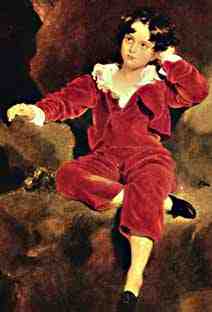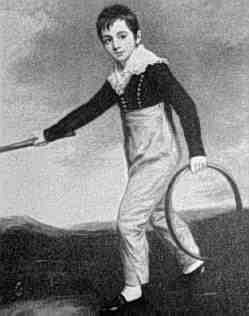Skeleton Suits: Garments
The skeleton suit was a fashion staple for boys. It came in one
and two piece styles with numerous buttons in necesary places. The basic
garment for one piece suits was a kind of jump suit. The two piece
suits consisted of a jacket and trousers and were worn with blouses.
There were also a variety of accessories such as military caps, sashes,
stockings, pantaleetes, and strap shoes were often worn with skeleton
suits.
One-piece Suits
The one piece suits were popular in the early 19th Century. The were
most commonly worn by younger boys. The high waist was the single most
prominent feature of the suit. It reflected the high waists in clothing
for men. The first two decades
of the 19th century were the period in which the Empire fashion raised
waistlines of mother, daughter, and small boy up under the arms. Men's
fashions also had high waists, but not generally as high as those of
children and men. This
basically classic high-waist style was loosely patterned on ancient
Greek fashions.
Skeleton suits for younger boys might be one-piece garments like the
worn by Thomas John (figure 1). The one piece suits were rather like
jump suits with the jacket and trousers combined in one
front buttoning outfit. Such suits jumpers might
be made of brown linnen or kerseymere white cambric.
As they were for younger boys there were generally white frills at the
collar and even the ankels as young boys might wear pantalettes.
Jackets
Two piece skeleton suits consisted of a tight, short jacket and usually
matching trousers. The colors could be contrasting, but this was unusual.
The shork jacket contrasted to the longer jackets wornnby adults. This
was the precursor for short jackets as a juvenile fashion. Presumably
the short Eton jackets for new boys at Eton
College derived from this fashion. Some of the jackets instead of fastening to the pantaloons
were worn with one-piece suits.
|
Trousers and Pantalooms
The skeleton suit consisted of both jacket and pantaloons as trousers
were first called. The pantaloons which began to be worn in
the 1790s
replaced knee breeches which men of status continued to wear well into
the 19th century. The pantaloons were usually cut to be relatively
tight and form fitting. The pants worn by boys with skeleton suits played
a major role in introducing long trousers to
adult men in Europe and America, a fashion which did not become widely
accepted until
the 1820s.
Pantaloons
The pantaloons were long, but usually not cover the boys ankles. The jacket or blouse was often tucked into the trousers and buttoned well above the waist. The trousers buttoned on to the jacket to hold then up, sometimes with a multi-buttoned front pannel. This is a deature we do not fully understand. We think it appeared in the late-18th century, but we are not yet positive about this. It was not a specifically boys' style. We also see men wearing flao-front trousers, both civilians and sailors. A reader writes, "I was thinking about the flap front for sailor's trousers. Could it have been copied from the Regency period when gentlemen's breeches had a similar front opening? I saw a note somwhere that in the early days when women started to wear trousers, their garments were often 'sailor style'. This was apparently more acceptable than traditional men's style trousers." This is a topic we need to investigate more fully. As it occurred in the era before photography, it is a difficult subject to research. Boys never wore belts with skeleton suits. Interestingly their fathers at the time wore knee length pants and looked down on long trousers as plebian. The boy's trousers amd jacket might have been made of silk or velvet.
Pantalettes
Men and boys in the 18th Century wore kneebreeches with white stockings. The new pantaloons covered most of the leg, but not the ankle. As the 19th Century progressed, it was not considered appropriate for either boys or girls to show their legs. Some reports suggest that the pataloons for younger boys were trimmed with lace. This probably refers to pantalettes that younger boys, girls, and women. Little boys wore them with both dresses, tunics, and skeleton suits. In fact pantalettes were the first trouser-like garments worn by boys. many boys wore them while still in dresses.
|
Blouses and Collars
Sometimes boys just wore a blouse without a jacket. Deep frilled turned down, ruffled collars were especially elaborate for the younger boys. Ruffles were also often employed at the he wrist. While ruffled collars were common, lace was rarely employed--perhaps because of cost. The blouses were always long sleeved. Young boys might wear dresses with short sleeves, but never
short-skeeved shirts and blouses. Older boys might wear plainer collars. In the latter period of skeleton suits, a large Eton collar might be added for older boys who would soon graduate to Eton suits.
Accessories
There were also a variety of accessory clothing items such as military caps, sashes, stockings, pantaleetes, and strap shoes were often worn with skeleton suits. These items varied over time, by country, and
according to a mother's preferences.
HBC
Navigate the Historic Boys' Clothing Tunic pages:
[Return to the
Main skeketon suit page]
[Historical trends]
[Stylistic features]
[Skeleton suit styles]
[]
[Skeleton suit accesories]
[Pantalettes]
[Stockings]
Navigate the Boys' Historical Clothing Web Site:
[Introduction]
[Activities]
[Biographies]
[Chronology]
[Cloth and textiles]
[Garments]
[Countries]
[Topics]
[Bibliographies]
[Contributions]
[FAQs]
[Glossaries]
[Images]
[Links]
[Registration]
[Tools]
[Boys' Clothing Home]
Created: February 3, 1999
Last updated: 8:56 PM 3/31/2010




